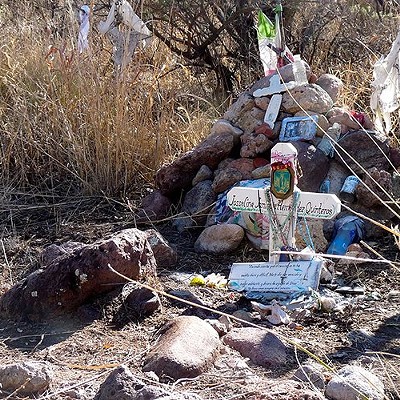Norteño music tinkles in the background as the bride and groom--Nora and Roberto--greet their family and friends, hugging, kissing, squealing. The evening air is cool, and the bride, in strapless white, and the bridesmaids, in strapless red, are shivering. They're not the only ones dealing with the winter chill.
Standing around the plaza are small clusters of men with the unmistakable look of migrants en camino--en route--to the United States. Dressed in dark, dusty jackets and pants, knitted caps and work boots or sneakers, already they have the look of weary travelers. Christmastime it may be, but these migrants have recently left their homes in villages all over Mexico to try for jobs in the United States. Many, like Martín Ramos, 45, from the southernmost state in Mexico, have already traveled long days and nights.
"I'm from Tuxtla Gutierrez, in Chiapas," Ramos says the next morning. "I came from Chiapas yesterday. I spent three nights and two days on the bus."
A couple of hours south of the border on an impossibly bumpy dirt road, Altar is the current gathering place for migrants hoping to enter the United States via Arizona. Border policy has made the crossings increasingly difficult in urban areas, pushing the human traffic into the countryside. Right now, Altar, the jumping-off point for the border crossing at Sasabe, Ariz., is the hot spot.
Life goes on as usual in this provincial town--weddings takes place, couples crowd into cantinas on a Saturday night--but for the last five years, Altar and its economy have been caught up in the migrant trade. Casas de huespedes, or guesthouses, a species of migrant flophouse, have proliferated. Stores do a lively business. In a shop across from the plaza, a young clerk named Mercedes Celaya says that popular migrant items are bottles of water ("They buy four gallons when it's hot, two gallons now"), rehydrating fluids, telephone cards, canned tuna and toenail clippers to open the cans.
"For the journey, they bring prepared food," says Celaya, adding, "Some of the migrants are sad."
And though the prices seem reasonable to an American--7.5 pesos for tuna--Altar's lone priest, Father René, makes them the topic of his sermon the Saturday night of the wedding. He hurries from the festivities in the plaza to a shelter run by the Catholic Church to say a "migrant Mass," where he chides his parishioners for jacking up prices and taking advantage of desperate travelers.
Migrants may find Altar difficult and pricey, but the worst is yet to come for Ramos and others in his position. Here, by the church, in the plaza, migrants look for coyotes to take them across the border at Sasabe, a rough frontier-style town just south of Arizona's Baboquivari Peak, in remote desert country. If the migrants are lucky, and the coyote keeps his word, he'll travel with them by foot into the desert for as many as three days. After that, assuming they don't get picked up by the Border Patrol or they don't get sick or injured or lost, the coyote's network of trucks and vans can take them anywhere in the United States.
"It's possible to go without a coyote, but it's dangerous," explains a migrant recently deported from Kentucky, who gives him name only as José. "The desert is a big place, and you can get lost."
Unlike Ramos, who lodged in a casa de huespedes, José has landed in the free migrant shelter run by the Catholic Church. And unlike Ramos, who says he has no contacts in the United States, José already knows the ropes. The last time he crossed the border, he says, "We walked three days with the same guide, and he had a guy waiting with a truck."
Another man at the shelter, César, recently got caught in Chattanooga, Tenn., and kicked out of the country. He says the usual fee for a coyote is $1,500 to $1,700. Last time, he traveled with a group of 15.
"We'll trust them again," he adds. "God knows we need the work."
WORK, OF COURSE, IS THE reason all these people are so far from home and planning such a dangerous journey. Until now, Mart'n Ramos says, he has worked in the sewers in the Tuxtla Gutierrez, capital of the poverty-stricken state of Chiapas. He made 48 pesos a day, hardly enough to support himself, his wife and their two children, ages 6 and 7.
A young Chiapas friend he's met on the journey, who gives only his first name, Ebert, is a campesino, a farmworker who used to grow corn and coffee. But the United States is selling cheap Midwestern corn in Mexico, courtesy of NAFTA, undercutting Ebert's home-grown, and a worldwide glut of coffee has pushed down prices everywhere.
"There's not a market for coffee and corn now," Ebert, 22, explains. "I have two children, 5 and 3, and I have to see if I can find a better job."
The tales are the same all over. José worked on a tobacco plantation in Kentucky, where he had a good boss and earned $10 an hour. César worked construction in Chattanooga, making a good living. Both eventually got caught by the American authorities--José in a roadblock, César in a minor traffic accident--but they'll do what they can to get back.
And despite the importance of the Christmas holiday in Mexico, they're making the journey this month. Migrant numbers drop in December, but sizeable numbers do continue to come, says Jésus Martinez, the volunteer director of the Catholic shelter, whose acronym CCAMYN translates loosely as Community Center for Migrants and Those in Need.
"Now there are about 300 to 500 daily," Martinez says. "From January to April sometimes there are as many as 1,000 daily. ... Right now, in December, there are not as many migrants, but you'll still see lots of them in the streets and the stores. It will pick up in January."
Ramos, the Chiapas man, says that Christmas was not much of a consideration in his plans.
"I didn't think about it from one moment to the next," he says. "I just came."
UP IN TINY SASABE, WHERE the migrants like Ramos will cross, pickups bounce around rutted dirt streets, and a skinny dog can be seen chasing a preternaturally calm pig. As in Altar, tinkly norteño music tumbles out of doors.
Victor Armendariz is an agent here with Grupo Beta, and in the town, between coyotes and drug traffickers, "There is no law." He and the 10 other Beta agents in town are paid by the Mexican government, "to take care of migrants. We talk to them about the risk of being abandoned in the desert, of problems with the Border Patrol. ... We ask how they are, and we give them food and water."
Migrants tend to fall out of the news in the winter; it's the searing desert summers that claim headlines and scores of migrant lives. At this time of year, Armendariz advises migrants to bring "plastic bags to cover themselves from the frost. Out here, if you get wet, you're going to die. But the cold time is not as dangerous as the heat. During the winter, you won't need as much water."
Standing at a flimsy barbed wire fence at a popular crossing point just west of Sasabe, Armendariz looks over into the rolling hills of Southern Arizona, where a Border Patrol officer gets out of his SUV and looks right back. The Mexican agent says the numbers of Christmastime migrants surprise him, but only a little bit.
"It's odd because Mexicans are supposedly religious, and December is the month of the Virgin," Armendariz says, smiling a little. "But it's la necessidad, necessity."
















